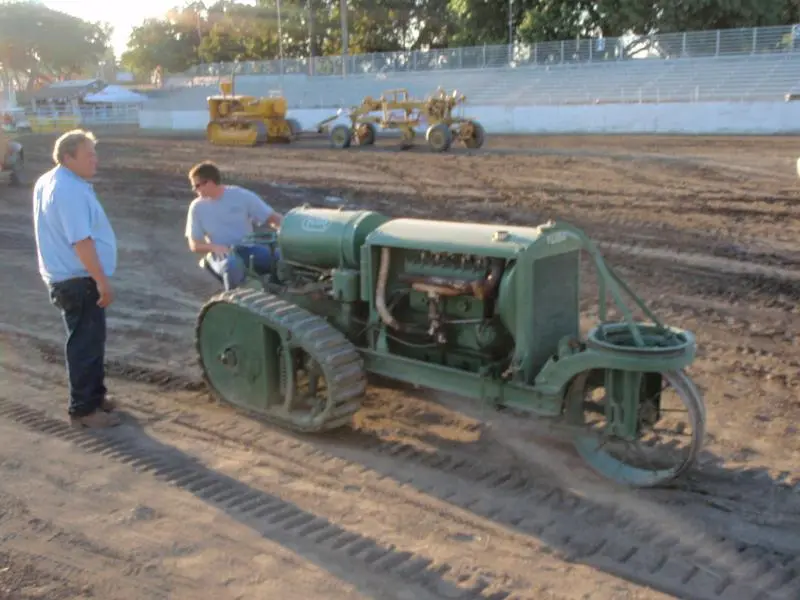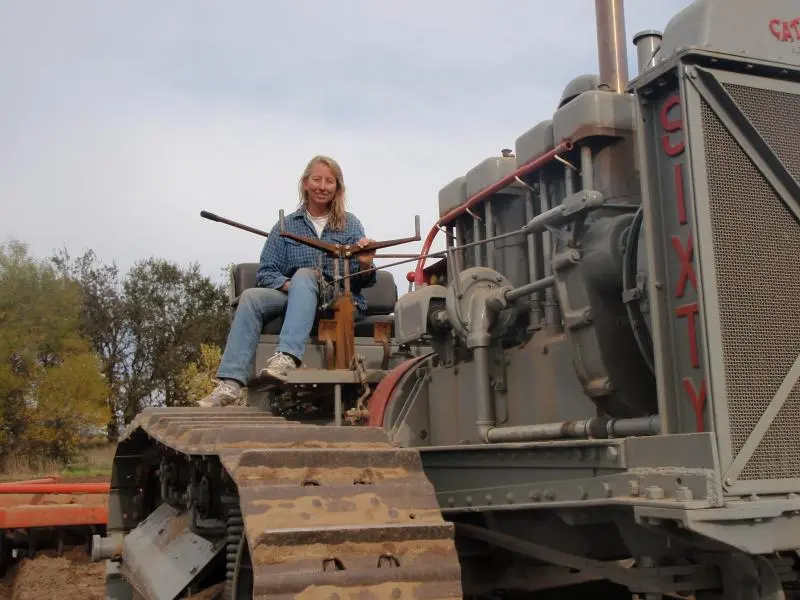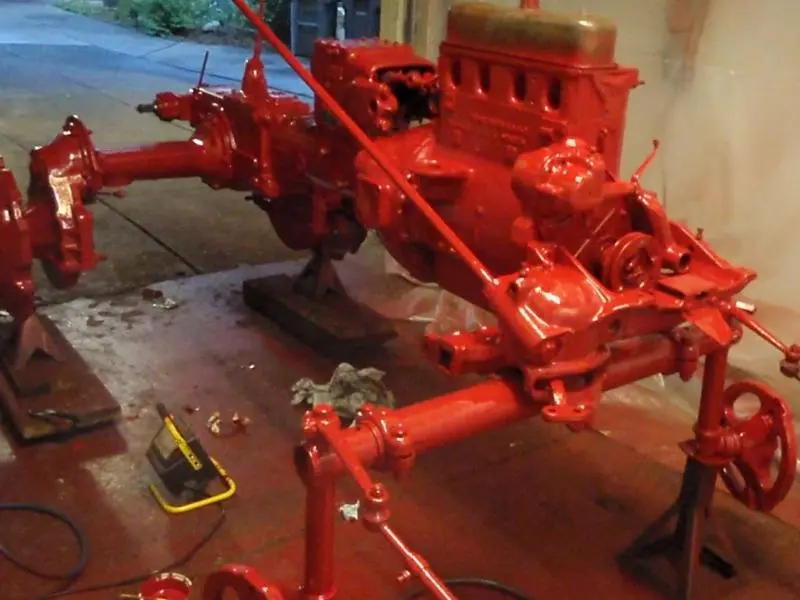


If you're really concerned about the lead, you should consider using a chemical paint stripper instead, at least to start and get most of the paint off. Stick with Jasco, the "friendlier" orange stuff doesn't work as well.
Whatever you do, don't skimp on the primer - get a good one! A lot of labor goes into a good paint job, and you don't want to spoil it by using inferior supplies.
I just put red Imron on my Farmall, and it turned out pretty well, although the Imron was pretty difficult to work with (very temperature and primer sensitive) and I had to redo the fuel tank. By then I really knew what I was doing and it turned out the best. People love the paint job - it looks really "wet." I got some halogen lights on stands - they were essential so I could see what I was doing.
I'm working out of my garage, so I used a combination of wirewheeling for the big stuff, sandblasting for the smaller stuff, and sanding, bondo, sanding primer, and glazing putty only for the sheet metal (it didn't have much rust). I prefer to take as many things off as is practical and paint the small things individually. I don't like to see an alternator painted anything but black, for example, and I don't like paint on wires and spark plug leads, but it depends on your taste. And that's what counts - will you be happy with the outcome if you paint your magneto and spark plug leads yellow? Many would, and that's OK. Every tractor has a different paint job to match the tastes of the owner. I like details to be free of paint - you can't see it in these pictures but I put new black rubber boots on the steering linkages and it really makes it look good. I removed the serial number plate and riveted it back on when I was done.
The Imron thins with acetone - when I ran out of good acetone & used the stuff I got from Orchard Supply, the part I was painting got the weirdest bubbles in it - they were perfectly round and stood out from the paint about 4 mm. Who would have thought that something like acetone would be available in different qualities???
Don't get me wrong, if this is your first paint job, DON'T use Imron.
I'd find a good automotive paint store, an informative store clerk, and take notes! Their product may be more expensive that what you'd get at Tractor Supply, but it's better quality and the staff in those stores know a lot and are a great resource.
Oh, and yes, my garage floor is now red. Guess how much I care?
[attachment=14957]P1010002-001.jpg[/attachment][attachment=14955]P1010001.jpg[/attachment][attachment=14956]P1010002.jpg[/attachment]
Pete--if you are really worried about the lead in the old paint dust you should use a HEPA breathing filter and cheap disposable coveralls, gloves and a protective hood. The shop will have to be vacuumed thoroughly when your done blasting or sanding.
We always specified these precautions on our bridge painting projects. Lead poisoning occurs on a time weighted average--so low concentrations for a longer period are equal to high concentrations for a shorter period. Workers in the industry have lead concentration level blood tests before, during, and after the project. I do not think you would have to do that.
As Barstart pointed out, all acetone is not the same. A few years ago I wiped a a part with some acetone preparatory to painting it only to have the paint flake off not long after it dried. This was the ordinary hardware store stuff and come to find out, the cheapie stuff has some sort of oil in it! Go to a regular paint store and get the more expensive stuff.
Here's a link that might explain it a bit better http://www.sigmaaldrich.com/chemistry/solvents/learning-center/solvent-selector.html
Peter,
I used to help my dad spray paint all of our tractor-trailers in our small family owned trucking business in Vermont. When we changed over to Imron paint my dad sprayed using his old respirator, and he passed out from the Imron. I suspect that Imron was a contributing factor in his death from pulmonary fibrosis.
If you are going to spray Imron, or any two part paint, BE SURE TO USE THE PROPER RESPIRATOR!
BTW, I like to use cold galvanizing compound, also known as Zinc Rich, as the primer for equipment that will see lots of time outside.
Ray
Its tough to get a zink primer now days, used too be common on airplanes--no more says the EPA,
I know a guy that has panted 30+ airplanes with Imron using all the proper gear including an air supply resierator, he quit using Imron after he got sick after the last few paint jobs.
[quote="Steve A"]Its tough to get a zink primer now days, used too be common on airplanes--no more says the EPA,
I know a guy that has panted 30+ airplanes with Imron using all the proper gear including an air supply resierator, he quit using Imron after he got sick after the last few paint jobs.[/quote]
Steve,
You can buy Zinc Rich primer (cold galvanizing compound) at Home depot in rattle cans, or at any welding supply shop.
You can buy Rustoleum Cold Galvanizing Compound in gallon cans ($135) or quarts ($35) or rattle cans ($😎 at Zoro tools, http://www.zorotools.com/g/00060648/k-G1763343?&gcsct=0ChMIwOyywdHosgIVgV_mCh14AwAAEAM
Ray
Read the direction on the cold galvanizing cans carefully: some brands do not recommend top coating as there will be no adhesion, the cheap ones are not so good.
I was refering to Zinc Chromate Primer, but after a quick google I see you can buy the stuff anywhere.
Disregard my above post as it seems I am loosing my mind
Okay, thanks for all of the tips everyone. I think that I will try the paint stripper as much as possible. I am disassembling it to replace rollers, idlers, seat and fenders, and clean the fuel tank. Might as well take off a few more parts while I am at it.
I don't intend to make it as nice as your Farmall, Barstart. Very Nice!!!!!!!!!!! Worth the red floor.
Thanks
Pete